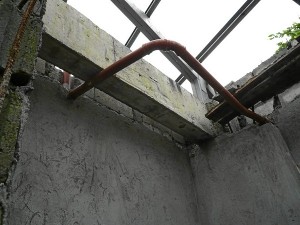The running cost of renovations

MUCH of the trouble in renovating stems from the unknown within unseen spaces, like pipes running inside your ceiling voids.
Fixing up an old property so as to upgrade it into a new one poses many challenges. While renovating is usually the cheaper option to rebuilding from scratch, it comes with a cost that is often more expensive than paying the price of money: the price of one’s sanity.
Renovations are like Pandora’s box—once started—both design and cost go awry. Trying to adjust design parameters according to what is actually there can be consuming— time and emotion wise. And cost, oh well, you’ll find yourself trying to close that box.
Renovations are done for several reasons. Primarily, it is for the reconditioning of the worn and torn that occurs both at the obvious superficial surface of a structure and in its less visible insides where the “operating systems” exists. The electrical, fire and life safety, plumbing and drainage, mechanical, structural and other systems are the invisible lifeline that bogs down in time.
Even structural systems, the most solid part of any building assembly, can eventually deteriorate. At other times, spaces are renovated to refresh an overstaying style, or to change an outgrown identity. It also helps to look trendy or new as it puts up with the competition.
Greatest difficulty
But renovating isn’t easy, and the greatest difficulty is working half-blind on what lies within unseen or concealed parts of the structure, especially when the construction plans no longer exist or when actual construction deviated from the official plans and specifications.
When executing new construction, it is wise to use an extra set of blueprints for recording and piecing together the bits of information on the items and systems installed. It should make note of the methods too. These “as-built plans” will be valuable in guiding you through any future renovation.
To minimize surprises during renovation work, do your due diligence by inspecting all the hidden places. Peek into ceilings and other void areas like drywalls, the hollow behind the closet baseboards, and other closed out and unused spaces.
Test the stability of your electrical lines, the flexibility of your conduits, the sturdiness of the frames that carry your ceilings. See how much of your wall paint will easily come off if forcibly scraped. Knock on your tiles to see if they’re about to delaminate.
Contingency sums
Because renovations are modifications on things that affect the unknown, contingency sums in your budget is a must because despite whatever measures you may have already made, there will surely still be surprises. Remember that your house, or structure, or workspace, is like a living organism—one finish or material or system terminates unto another, and changes can run a bit like wildfire. Give ample budgetary allowances for unexpected conditions at the site.
And to give value to the already inflated budget issues, you must consider the lifetime of the installations you might decide not to upgrade. As an example, if you were replacing bath fixtures, fittings and tiles in a bathroom, you may want to consider removing and reapplying the waterproofing membrane that lines the slab underneath the tiles. As good as it may still seem to be, it could be nearing the end of its lifetime, and any future failure in the waterproofing will require the removal of all tiles again.
The same goes for old plumbing like the galvanized iron pipes of yore that may be seemingly in good order but maybe rusty underground. Or the old, first-generation PVC pipes that are not broken but have become brittle, and can break anytime soon. Or the large sewer pipe that seems to drain properly, but has already accumulated dirt that hardened—much like the cholesterol in your arteries—and will eventually narrow the passages, causing clogging.
Less painful way
Building from scratch may still be the less painful way to build, and using high-quality materials and installations is a must. But the reality of renovations is inescapable.
Superficial changes are usually more predictable in terms of cost and are also less emotionally exhausting, but nothing beats knowing that what is inside is just as good as what you see on the outside. The near-painless way to renovate is with a lot of preparation, due diligence, realistic expectations and a contingency on your budget. This way, you may even be able to maintain a good measure of sanity.
Contact the author through designdimensions@abi.ph or through our Asuncion Berenguer Facebook account.
